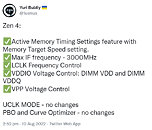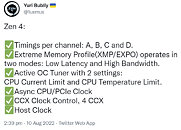TheLostSwede
News Editor
- Joined
- Nov 11, 2004
- Messages
- 18,921 (2.50/day)
- Location
- Sweden
| System Name | Overlord Mk MLI |
|---|---|
| Processor | AMD Ryzen 7 7800X3D |
| Motherboard | Gigabyte X670E Aorus Master |
| Cooling | Noctua NH-D15 SE with offsets |
| Memory | 32GB Team T-Create Expert DDR5 6000 MHz @ CL30-34-34-68 |
| Video Card(s) | Gainward GeForce RTX 4080 Phantom GS |
| Storage | 1TB Solidigm P44 Pro, 2 TB Corsair MP600 Pro, 2TB Kingston KC3000 |
| Display(s) | Acer XV272K LVbmiipruzx 4K@160Hz |
| Case | Fractal Design Torrent Compact |
| Audio Device(s) | Corsair Virtuoso SE |
| Power Supply | be quiet! Pure Power 12 M 850 W |
| Mouse | Logitech G502 Lightspeed |
| Keyboard | Corsair K70 Max |
| Software | Windows 10 Pro |
| Benchmark Scores | https://valid.x86.fr/yfsd9w |
If you remember, there were quite a lot of discussions about memory speed "sweet spots" for both the Ryzen 3000- and Ryzen 5000-series, with the user experience not always meeting AMD's sweet spot for memory clocks. Now details of the Ryzen 7000-series memory sweet spot has arrived courtesy of Wccftech and the speed is said to be DDR5-6000. This is 400 MHz higher than the apparent official maximum memory clock speed of DDR5-5600, but as we know, the manufacturer's max memory clock is rarely the actual max. In AMD's case, things obviously work a bit differently, as the Infinity Fabric clock should ideally run at a 1:1 ratio with the memory in the case of the AM4 platform, to deliver best possible system performance and memory latencies.
That said, as we're using DDR memory, the actual clocks are only half of the memory speeds, so the IF clock is operating at no more than 2000 MHz if the memory is DDR4-4000. However, if the same applies to the Ryzen 7000-series, it appears that AMD has managed to bump the IF clocks by a not insignificant 1000 MHz, as the IF fabric would now be operating at up to 3000 MHz. This could see the Ryzen 7000-series offering better memory latencies than Intel's Alder Lake and upcoming Raptor Lake CPUs, as Intel is running DDR5 memory at a 2:1 ratio or a 4:1 ratio. AMD is said to still have a 2:1 ratio as well, but as with the AM4 CPUs, this offers worse overall performance.
Update 11:49 UTC: Yuri Bubliy aka @1usmus has confirmed on Twitter that the max IF frequency of 3000 MHz and it seems like AMD has added a range of new memory and bus related features to the AM5 platform, going by the additional features he posted.



View at TechPowerUp Main Site | Source
That said, as we're using DDR memory, the actual clocks are only half of the memory speeds, so the IF clock is operating at no more than 2000 MHz if the memory is DDR4-4000. However, if the same applies to the Ryzen 7000-series, it appears that AMD has managed to bump the IF clocks by a not insignificant 1000 MHz, as the IF fabric would now be operating at up to 3000 MHz. This could see the Ryzen 7000-series offering better memory latencies than Intel's Alder Lake and upcoming Raptor Lake CPUs, as Intel is running DDR5 memory at a 2:1 ratio or a 4:1 ratio. AMD is said to still have a 2:1 ratio as well, but as with the AM4 CPUs, this offers worse overall performance.
Update 11:49 UTC: Yuri Bubliy aka @1usmus has confirmed on Twitter that the max IF frequency of 3000 MHz and it seems like AMD has added a range of new memory and bus related features to the AM5 platform, going by the additional features he posted.



View at TechPowerUp Main Site | Source





 But on the plus side it's still in 1:1 ratio, rather than 1:2 on Intel, so there could be major latency benefits for gaming scenarios.
But on the plus side it's still in 1:1 ratio, rather than 1:2 on Intel, so there could be major latency benefits for gaming scenarios.

